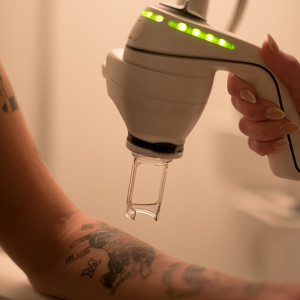MAY 5, 2022


Are laser tattoo removal side effects an issue?
At NAAMA, we want to make laser tattoo removal easily accessible for all of our clients, but we encourage all of them to keep in mind that it is still a medical procedure.
And with any medical procedure, no matter how routine, there are still small risks and side effects.
Many of our clients have questions about the risks of laser tattoo removal treatment. For example, as well as common questions like will laser tattoo removal hurt, we’re often asked whether the treatment can cause permanent skin damage, damage the immune system or cause other things such as inflammation, which is why we’ve discussed the potential side effects of laser treatment to remove an unwanted tattoo below.
Publish Date in article


How does laser tattoo removal work?
To understand the potential side effects, it’s important to know exactly what the laser tattoo removal process consists of and why it is different from other tattoo removal methods. We use a laser that pulsates on varying wavelengths of light to blast the tattoo ink particles in your skin and break down the tattoo pigment, turning it into smaller pieces that can be processed and flushed out by your immune system. Our own unique laser technology has been specially designed and developed, operating on a different wavelength than most lasers on the market but at a lower energy. This is so that it achieves better removal results with less pain - the higher wavelength means more light is being absorbed by the ink, but the low energy keeps it gentle on the skin.

Every person and every tattoo is unique, so everyone reacts differently to treatment.

What are the side effects of laser tattoo removal?
Whilst our LightSense™ laser technology minimises some side effects and make laser tattoo removal safe, this will vary from person to person. Each removal journey is unique, but we strive to ensure the utmost safety in order to remove unwanted tattoos completely and minimise any adverse risks.
Laser tattoo removal side effects can include:
Frosting: Tattoo removal ‘frosting’ occurs as a result of carbon dioxide release, which happens when the laser penetrates the upper layers of the skin. It’s very common, but typically only lasts around 30 minutes or so after the treatment. It's called ‘frosting’ because it looks as though a layer of frost has formed on top of your skin.
Blisters: Blistering after laser tattoo removal is fairly common, and happens as a result of the laser heating up your skin and causing superficial damage to your blood vessels. Thanks to our low-energy design, the NAAMA laser doesn’t emit as much heat, which is why you are less likely to experience blistering.
Itching: Itching after your laser tattoo removal is a good sign. Just like when a scab or wound begins to heal, itching is a sure sign that your body is doing its job. As tempting as it might be during this period, you should avoid scratching at all costs as this could lead to scarring. Instead, apply appropriate skincare creams to keep the area hydrated.
Redness and swelling: You may experience some redness or swelling after a removal session, or you may have rash or hive-like symptoms. These can be alleviated through using recommended aftercare creams.
Pinpoint bleeding: A little pinpoint bleeding, or petechiae, is completely normal. It’s caused by small blood vessels bursting near the surface of your skin. This may lead to some scabbing after your treatment, and it’s really important not to pick these scabs as picking them will mean your skin takes longer to heal and the results may not be as good.
Change in appearance: It’s possible that your tattoo may appear elevated after a session of laser removal, and it may appear darker after the first session. Both of these potential side effects go away fairly quickly and are nothing to worry about.
Publish Date in article


Does skin go back to normal after laser tattoo removal?
At NAAMA, all clients and their tattoos are subject to a screening process prior to treatment, in order to ensure that their exact skin type is suitable for laser treatment. This allows us to reduce the risk of other side effects, such as hypopigmentation and hyperpigmentation. You may experience other symptoms immediately after your session, such as swelling or slight discomfort, but these should go away within a couple of days. If you’re concerned about any other side effects you might be experiencing, be sure to contact your tattoo removal consultant or your GP.
For trends in breakthrough laser tattoo removal technology, here are NAAMA's top laser FAQs.
What is the best laser for tattoo removal?
What is the newest laser technology for tattoo removal?











